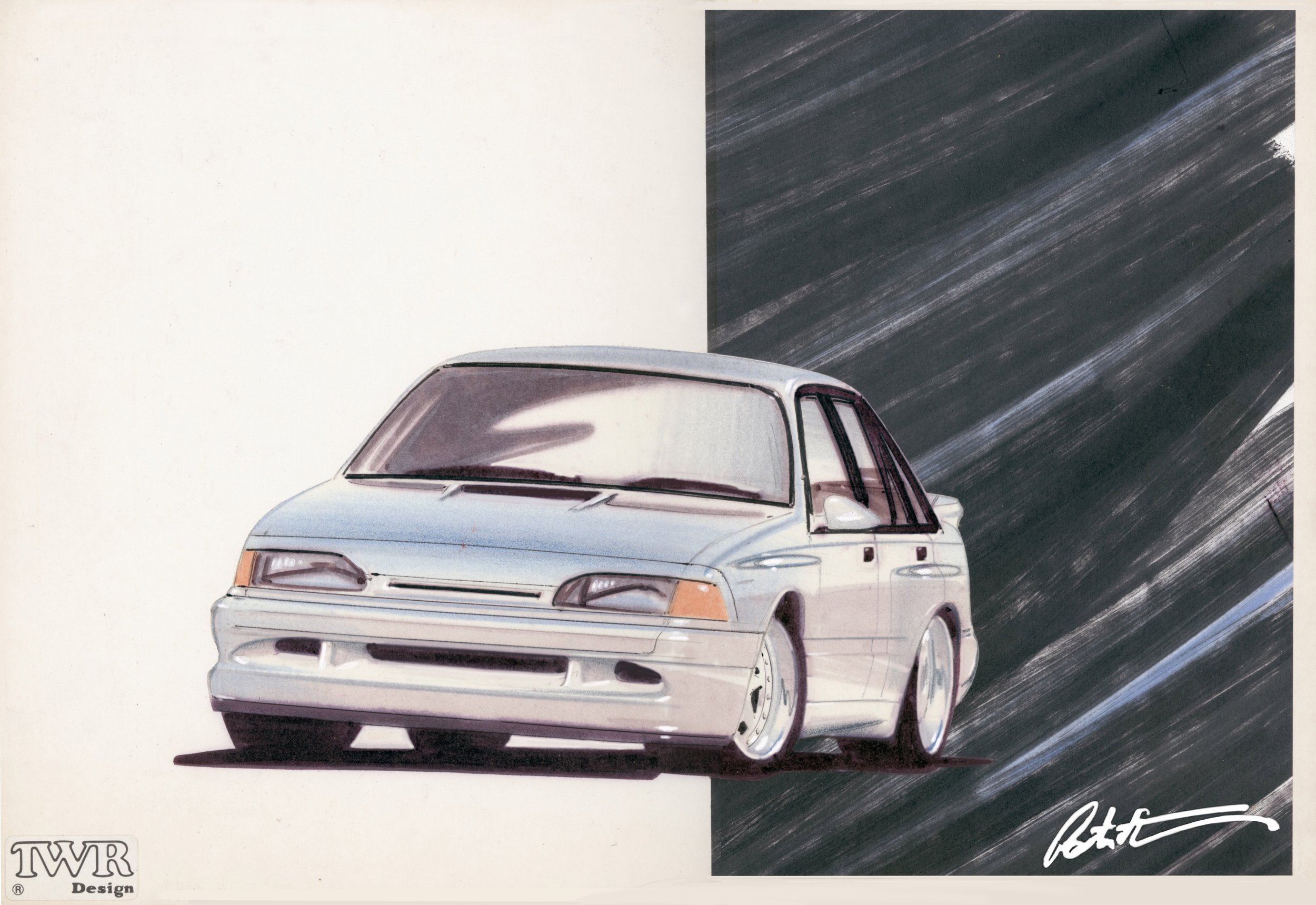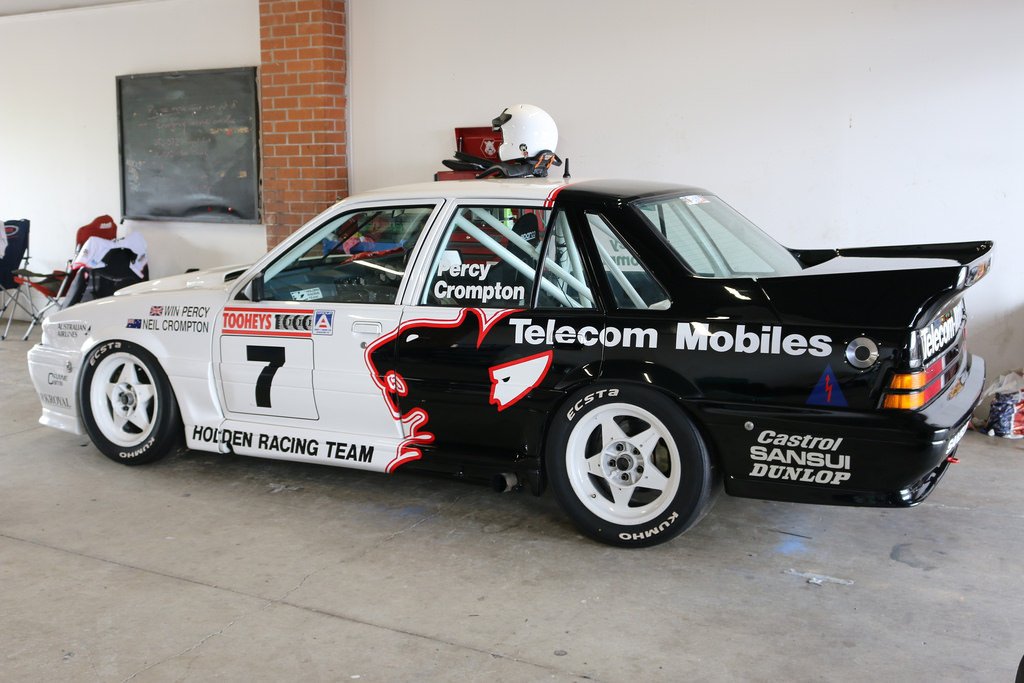Ground zero: the first ‘HSV’ VL Group A SS of 1988. But who designed it? Photo courtesy of HSV
I knew I was onto something big when I called Crenno and he said: “I don’t know.”
The saga started when a publisher commissioned me to write three chapters for a Holden Special Vehicles book. Could I cover styling and design, clay modelling, and concept cars?
You bet I could.
I began my research and mapped out every HSV model, then assigned a stylist to each one. I came up with Ian Callum (HSV designer from 1990 to 1998), Nel Simpson (1990 to 2003), Julian Quincey (from 2003), and Adam Dean Smith (2006 to 2010).
Many statement cars sat alongside their names: the VP Senator (1991), VS GTS-R (1996), VT ClubSport (1997), VX Maloo R8 (2000), VY Coupe GTS (2002), VZ Coupe4 (2004), E Series W427 (2006), E Series 2 GTS (2009), GEN-F GTS Maloo (2013), and sundry specials, concepts and limited edition models.
There were some misses, too: the Nissan Pulsar/Holden Astra-based SV1800 ‘Baby Walky’ hatches and sedans (1988); the Holden Jackaroo SUV ‘by HSV’ (1993); the VSII Manta wagon (1996); and the Opel-enhanced, HSV badged, Astra E Series VXR (2007).
So, I had my master list, but one car didn’t fit: the 1988 Holden VL Commodore SS Group A SV.
The Walkinshaw, the Batmobile, the Plastic Pig; call it what you will. This car set the tone for Holden Special Vehicles. It draws eyeballs, too. Love it or loathe it, no one can ignore the be-winged beast and every car designer who ever lived dreams of achieving that.
But who designed the Walkinshaw?
I asked Ian Callum. He didn’t design it and didn’t know who did. I questioned each HSV designer. They had theories but no answers. I probed every Holden Special Vehicles boffin I could find but ended up with a big, fat blank. So, when I called HSV founding boss and marketing guru, John Crennan and posed the question to him and even he didn’t know, I realised I had to solve this Australian automotive mystery myself.
I dusted off my deerstalker hat, polished my magnifying glass and conducted some old-fashioned detective work and, like Sherlock Holmes, developed a hypothesis. I tried it out on Callum and Crenno and they said, “You might be onto something, old chum.”
Okay, maybe they didn’t say that, but they agreed the name sounded right.
So, I did it. I got in touch with my mystery man, shone a high voltage light beam into his eyeballs, pressed my finger on his chest and demanded he answer the hard question: “Did you pen the Walkinshaw?”
He caved.
“I designed the Commodore for Tom [Walkinshaw] during 1987,” said Peter Stevens.
An early design sketch for the SS Group A by Peter Stevens while working freelance for Tom Walkinshaw’s TWR. Image courtesy of Peter Stevens Design
Peter Stevens, the British-born designer of the McLaren F1, Jaguar XJR-15, Le Mans-winning BMW V12 LMR, and many other memorable cars. Peter Stevens, design legend, styled the first ‘HSV’.
Now, although the VL Commodore SS Group A didn’t wear HSV badges – Holden wanted to homologate the sedan for racing – the Panorama Silver beast is ground zero, model number one, in the Holden Special Vehicles history book. The car’s butch add-ons included a bonnet bulge and look-at-me boot spoiler, along with pumped-up side-skirts and bumpers. Not to everyone’s taste, for sure, but the kit served a purpose, and the car came about like this...
Holden appointed Tom Walkinshaw in 1987 to head its new go-fast division – which became Holden Special Vehicles – in the wake of the Peter Brock fallout. Walkinshaw later recruited Holden executive John Crennan as HSV’s first managing director and, although they often butted heads, the partnership thrived, and this brought about some of Australia’s most desirable home-grown cars.
Crennan recalled seeing the Group A’s lines for the first time in mid-1987.
“I was with Tom [Walkinshaw] at the Regent Hotel (in Melbourne), and, on a napkin, he sketched out the Group A. He had clear ideas about the aerodynamics for the car,” Crennan told me.
Walkinshaw took the napkin back to Kidlington, in the UK, and built the first of a legendary series of HSV cars.
The Tom Walkinshaw Racing founder planned to create subsidiary consultancy, TWR Design with legendary pen-man Peter Stevens. This never eventuated, but Stevens, working freelance, styled the first HSV, the VL Group A, for Walkinshaw and they always called it the TWR Holden.
“Tom and I put together the idea for TWR Design in the mid 1980s, although I was still working as a consultant. I had worked on the Rover 3500 Group A cars, the 5 Series BMWs, the Spa 24-Hour winning Mazda RX-7s and, of course, the Jaguar-Sport XJR-15,” said Stevens.
In fairness to Crennan – and journalist Paul Gover who wrote about the Group A’s design in an issue of Australian Muscle Car – when I mentioned Peter Stevens might be our mystery stylist, Crennan recalled the Regent Hotel meeting with Walkinshaw and added, “He may have given that (sketch on the serviette) to Peter Stevens, I don’t know. I know he worked with Tom, so he could have done the design.”
Tantalising, but hardly convincing. Every court in the land would throw that reminiscence out if offered as ‘proof’. I had to hear the story first-hand.
“I always used to say of Tom that ‘No one got up earlier than Tom Walkinshaw’,” said Peter Stevens.
Walkinshaw pegged the VL Commodore as an ideal base for international Group A racing. Holden also wanted – and needed – to build a limited run of road cars. Walkinshaw briefed Stevens and showed him the donor car but, as always, looked for a competitive edge.
“He always liked to be ahead of the game. He would spend hours looking at the class or series rules with a magnifying glass,” said Stevens.
Walkinshaw became famous – or infamous – for finding advantages between the lines of the rule book.
The infamous ‘coffee table’ rear deck that later became the SS Group A car’s most distinctive feature. Photo courtesy of Peter Stevens Design
“He and I [read] the Australian Group A ‘regs’ and noticed both the rear screen and boot lid were described as being ‘free’,” said Stevens.
“What this was supposed to mean was the rear glass screen could be replaced by a Plexiglas screen, and the steel rear deck ‘boot lid’ could be replaced by a fiberglass panel. What it did not say was that either component had to be the same shape as the original.”
Stevens knew from previous wind tunnel work that if TWR cranked the angle of the upright rear glass to a flatter slope, more air would reach the deck lid, particularly if he raised the rear deck surface.
“Separate deck mounted rear wings were not allowed, but a deck mounted spoiler was, thus I could raise up the rear surface to such a height that the spoiler became a very effective drag reducing, but also lift reducing, element.
“After I had established the rear-end design, I could then add a front lower splitter to appreciably cut front lift and reduce drag. The side sills also cut both lift and drag. This all added considerable performance to the race cars, looked aggressively tough, and caused TWR to build a small run of road cars. Tom was always up for making a buck.”
In December 1987, inspectors from the Federation Internationale du Sport Automobile (FISA) – the international motorsport governing body until the FIA took over in 1993 – refused to homologate the TWR Holden, disputing the legality of the panel covering the ‘sixth window’, just in front of the C-pillar. One can imagine Walkinshaw stepped up to the FISA boffin and, in his best Scottish brogue, said: “What ya talking about, laddie? Of course she’s legal. Look at her. She’s a work of art, she is.”
The car passed scrutineering.
So, British designed – in Britain – but an Australian design legend made an important contribution to the early race cars.
“Mike Simcoe was responsible for the great-looking Holden Racing Team graphics,” said Stevens.
“When he came over to the UK to see the first car, he was a bit blown away by how outrageous it looked and threw himself into the black, red and white livery.”
Holden designer Mike Simcoe conceived the Group A Holden’s distinctive livery. Photo courtesy of Peter Stevens Design
Tom Walkinshaw recalled Holden “wanted to have a Group A car and the shape of the car at the time; it would lift at the rear. So, the only way we could get around it in the wind tunnel; we had to keep lifting it at the boot and it got higher and higher and higher until we had this huge tray on the rear, and we had to figure out how on earth you could actually style that into the rest of the car.
“So, we took the rule book and made everything the maximum dimension we could, and the car ended up the way it ended up.”
HSV had a problem, though. The fiberglass kit weighed 65kg.
“If it had any more fiberglass on it, it would have fallen over,” said Tom Walkinshaw.
The body kits proved a major challenge on the HSV factory line in Victoria, as well.
Holden provided the donor cars and HSV fitted Peter Stevens’ body kit. HSV representatives sourced local suppliers for the fiberglass parts and first approached Bolwell, experts in fiberglass production – think Ronald McDonald statues, playground equipment and classic Aussie cars – but the company knocked back the commission.
Eventually, three or four suppliers produced and delivered the unpainted fiberglass sections, but the panels became a nightmare for the fledgling company and the estimated unit cost skyrocketed.
Holden provided a base VL Commodore, which HSV staff used to finesse the body kit. The new expert fiberglass recruits, under the watchful eye of race-ace John Harvey, then took moulds for the individual pieces from the ‘formed-up’ car. They had a problem, though, which Harvey traced back to the source.
Minor build variations in the Holden donor vehicles – the last cars built at GM-H’s Dandenong factory – proved troublesome when fitting the skirts, so HSV had to fit them in two parts.
Holden Special Vehicles factory staff also discovered that, while a panel might fit on one car, it would not fit on another and, with 750 vehicles passing through the Clayton facility, this became a colossal quality control headache.
Stevens designed the fiberglass body kit to ‘manage’ airflow around, through and under the car. HSV claimed tests in the Motor Industry Research Association (MIRA) wind tunnel in Warwickshire, UK, revealed the body kit reduced drag by 25 per cent over the previous Holden Dealer Team VK Group A car, with gains in high-speed downforce. In fact, Stevens’ design achieved a drag coefficient of 0.314, better than the much-hyped Jaguar XJ 220 (0.337).
Launched in 1988, the Group A’s body kit comprised 26 separate fiberglass pieces. Transforming the Holden base car with the kit, including tooling, painting and fitting, and rectification work, cost $6847 per unit. Holden priced the Walkinshaw at $45,500 (without options and before on-road costs), $13,500 more than a Calais Turbo.
Holden had to build 500 units to score FISA homologation. At some point, HSV executives and their appointed dealers got a little too optimistic and commissioned a further 250 cars. The first 500 cars sold quickly, but many of the remaining 250 overstayed their welcome in dealerships.
Resting on five-spoke 16-inch alloy wheels and 205/55 VR16 Bridgestone tyres, the TWR Holden looked tough as nails, but the styling did not convince everyone.
It’s said Holden executives didn’t much like the Group A car’s design, to which Walkinshaw retorted: “You want to win motor races, don’t you?” The Red Lion’s white collar brigade said of course they did, and the most distinctive HSV ever made became well-remembered and collectable.
Compare the Walkinshaw to the pinstriped SV88 from the same era. That car didn’t stand out from the crowd, and few recall it. There are other forgotten cars; vehicles that have followers, but which aren’t heroes of HSV’s back catalogue.
Why? Design, that’s why.
And Peter Stevens designed the hell out of the TWR Holden.
The finished VL Group A ‘TWR Holden’ stayed faithful to Peter Stevens’ design sketches. Image courtesy of Peter Stevens Design
Holden VL Commodore SS Group A SV
Engine: Fuel injected 4987cc Group A Holden V8; 178kW/370Nm
Transmission: Five-speed manual
Wheels: 16-inch alloy
Tyres: Bridgestone 205/55 VR16
Brakes: Ventilated discs (front); discs (rear)
Top speed: 235km/h
Stevens’ aerodynamic marvels
Stylists concern themselves not only with svelte lines and gorgeous compound curves. To claim supercar bragging rights or win races, their designs must contribute to low drag and lift.
The below chart shows what Stevens accomplished with the Holden Group A Walkinshaw, a sedan that lacks a supercar’s slippery aerodynamic lines.
“We never achieved big downforce figures for the Holden,” said Stevens.
His assessment is modest. Notice how favourably the Walkinshaw’s drag coefficient compares to the low-slung Jaguar XJ220 supercar, and beats the Porsche 956 Group C, and many other vehicles in the chart.
“Most companies who claim serious downforce are talking bollocks,” said Stevens.
“Cars like the Commodore, and like the equivalent Opel cars that I developed whilst at Lotus, would tend to have around 100kg of lift at the front at 160km/h and 150kg at the rear at 160km/h.
“My aim was always to match the centre of lift to the car’s centre of gravity to produce a stable platform. That meant, with a front to rear weight distribution on the race cars usually being 55 to 60 per cent of the weight over the front wheels and 40 to 45 per cent over the rear wheels, I would be looking for something like 10 to 20kg of lift at the front and five to 15kg at the rear at 160km/h.
“Some cars’ basic form made it possible to achieve zero lift, but this was rare. This always had to be whilst achieving a reduction in drag as well,” said Stevens.
Who designed the other early cars?
The TWR Holden remains Stevens’ only HSV design.
A major commission – one that secured the British designer’s reputation – landed on his desk and he moved on from TWR.
“When the McLaren F1 design job came up in 1989, I introduced Tom [Walkinshaw] to Ian Callum – or maybe Ian to Tom – so that there would be continuity of design input [at TWR Design]. I had previously taught Ian as an automotive student at the Royal College of Art,” said Stevens.
“TWR Design was always a very close-knit little group. There were a couple of excellent clay modellers who we all trusted implicitly to put our thoughts into three dimensions but, when I left and then a few years later when Ian left to take up the job at Jaguar and Neil Simpson moved to Australia, [TWR Design] became more of a modelling and show car shop with a couple of young inexperienced designers and no strong leadership.
“Soon after this, the TWR group got into financial difficulties and Tom became unwell. The situation was not helped by the failure of MG-Rover, who at that time had a couple of projects with TWR. Money was owed!” said Stevens.
Asked if he designed the other Holden Special Vehicles ‘foundation’ cars – like the Nissan Pulsar/Astra-based SV1800, the Commodore-based SV88, SV3800, and the VG Maloo Utility – prior to Ian Callum’s arrival in 1990, Peter Stevens had bad news.
“I didn’t work on these cars,” he said.
Stylists at TWR Design and Holden Design Studio most likely created the (mild) body kits on the other 1989 to 1990 vehicles, but what are their names? That’s another mystery...





